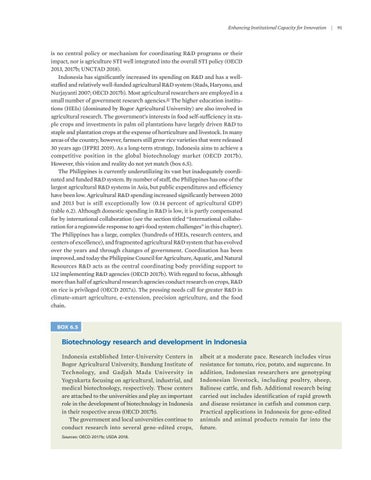Enhancing Institutional Capacity for Innovation | 91
is no central policy or mechanism for coordinating R&D programs or their impact, nor is agriculture STI well integrated into the overall STI policy (OECD 2013, 2017b; UNCTAD 2018). Indonesia has significantly increased its spending on R&D and has a wellstaffed and relatively well-funded agricultural R&D system (Stads, Haryono, and Nurjayanti 2007; OECD 2017b). Most agricultural researchers are employed in a small number of government research agencies.10 The higher education institutions (HEIs) (dominated by Bogor Agricultural University) are also involved in agricultural research. The government’s interests in food self-sufficiency in staple crops and investments in palm oil plantations have largely driven R&D to staple and plantation crops at the expense of horticulture and livestock. In many areas of the country, however, farmers still grow rice varieties that were released 30 years ago (IFPRI 2019). As a long-term strategy, Indonesia aims to achieve a competitive position in the global biotechnology market (OECD 2017b). However, this vision and reality do not yet match (box 6.5). The Philippines is currently underutilizing its vast but inadequately coordinated and funded R&D system. By number of staff, the Philippines has one of the largest agricultural R&D systems in Asia, but public expenditures and efficiency have been low. Agricultural R&D spending increased significantly between 2010 and 2013 but is still exceptionally low (0.14 percent of agricultural GDP) (table 6.2). Although domestic spending in R&D is low, it is partly compensated for by international collaboration (see the section titled “International collaboration for a regionwide response to agri-food system challenges” in this chapter). The Philippines has a large, complex (hundreds of HEIs, research centers, and centers of excellence), and fragmented agricultural R&D system that has evolved over the years and through changes of government. Coordination has been improved, and today the Philippine Council for Agriculture, Aquatic, and Natural Resources R&D acts as the central coordinating body providing support to 132 implementing R&D agencies (OECD 2017b). With regard to focus, although more than half of agricultural research agencies conduct research on crops, R&D on rice is privileged (OECD 2017a). The pressing needs call for greater R&D in climate-smart agriculture, e-extension, precision agriculture, and the food chain.
BOX 6.5
Biotechnology research and development in Indonesia Indonesia established Inter-University Centers in Bogor Agricultural University, Bandung Institute of Technolog y, and Gadjah Mada University in Yogyakarta focusing on agricultural, industrial, and medical biotechnology, respectively. These centers are attached to the universities and play an important role in the development of biotechnology in Indonesia in their respective areas (OECD 2017b). The government and local universities continue to conduct research into several gene-edited crops, Sources: OECD 2017b; USDA 2018.
albeit at a moderate pace. Research includes virus resistance for tomato, rice, potato, and sugarcane. In addition, Indonesian researchers are genotyping Indonesian livestock, including poultry, sheep, Balinese cattle, and fish. Additional research being carried out includes identification of rapid growth and disease resistance in catfish and common carp. Practical applications in Indonesia for gene-edited animals and animal products remain far into the future.

